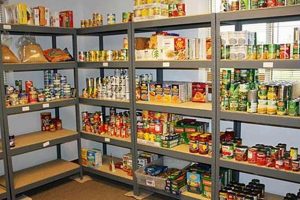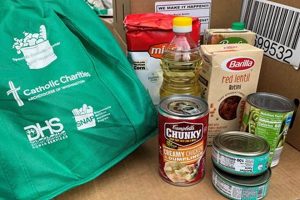The criteria that define who can receive assistance from a food distribution center are based on a number of factors. These factors generally include household income, size, and residency within a specific geographic area served by the pantry. For example, a family of four with an income below a certain threshold, as determined by federal or local guidelines, may be deemed qualified to access services.
These guidelines are crucial for ensuring resources are allocated effectively to those most in need within a community. They help pantries maintain operational efficiency by preventing over-subscription and allowing them to plan for the volume of aid necessary. Historically, such guidelines have evolved to reflect changes in economic conditions and the specific needs of the population served.
Understanding these prerequisites is the first step for individuals and families seeking assistance, as well as for those who wish to support these organizations. Subsequent sections will delve into the specific requirements commonly used, the documentation required, and the process for application and verification.
The following are guidelines intended to help potential recipients understand and prepare for the application process at local food distribution centers.
Tip 1: Research Local Guidelines: Different pantries operate under varying sets of criteria. Consult the specific requirements of the food banks within the individual’s geographic area before applying.
Tip 2: Document Income Accurately: Precise documentation of all income sources, including wages, benefits, and other forms of revenue, is crucial. Failure to provide accurate information may result in delays or rejection of the application.
Tip 3: Understand Household Definition: Food pantries define “household” in specific ways. Ensure a clear understanding of how the pantry counts members residing at the address, as this impacts eligibility calculations.
Tip 4: Gather Residency Verification: Most food pantries require proof of residency within their service area. Acceptable documentation typically includes a utility bill, lease agreement, or government-issued identification.
Tip 5: Inquire About Emergency Assistance: Many pantries offer temporary provisions in emergency situations, even if an applicant does not fully meet standard criteria. Understanding these options can provide immediate relief.
Tip 6: Explore Alternative Resources: If the pantry’s requirements cannot be met, investigate other support systems such as government assistance programs or charitable organizations within the community.
Tip 7: Maintain Open Communication: If uncertainties or difficulties arise during the application process, communicate directly with the pantry staff to seek clarification and assistance.
Adhering to these guidelines can enhance the likelihood of a successful application and expedite access to necessary food assistance.
The concluding section of this article will address common misconceptions and provide resources for further support.
1. Income Thresholds
Income thresholds serve as a primary determinant in assessing whether an individual or household qualifies for assistance from a food pantry. These limits, often defined in relation to federal or state poverty guidelines, aim to direct resources toward those with the most demonstrable financial need. They establish a measurable benchmark against which an applicant’s financial status is evaluated.
- Percentage of Federal Poverty Level
Many food pantries set eligibility based on a percentage of the Federal Poverty Level (FPL). For example, a pantry might serve households with incomes at or below 130% of the FPL. This allows for a standardized and nationally recognized benchmark, adjusted annually for inflation and household size. The precise percentage used can vary regionally and by pantry, reflecting local costs of living and resource availability.
- Gross vs. Net Income Considerations
Food pantries differ in whether they consider gross (pre-tax) or net (post-tax) income when evaluating eligibility. Using gross income provides a simpler, less nuanced assessment, while net income accounts for taxes and deductions, potentially offering a more accurate reflection of disposable income. The choice between gross and net can significantly affect who qualifies, particularly for low-income individuals with high tax burdens or significant deductions.
- Categorical Eligibility Overrides
Certain circumstances may override strict income thresholds. For instance, individuals receiving specific government benefits, such as Supplemental Nutrition Assistance Program (SNAP) or Temporary Assistance for Needy Families (TANF), might automatically qualify for food pantry services, regardless of their specific income level. These categorical eligibility provisions streamline the application process and ensure access for individuals already vetted through other social safety net programs.
- Impact of Household Size and Composition
Income thresholds are invariably linked to household size. A larger household necessitates a higher income threshold to account for increased expenses. Furthermore, the composition of the household (e.g., number of children or elderly dependents) can also influence eligibility. Some pantries adjust income limits based on these factors, recognizing that certain household structures face greater financial strain.
In conclusion, income thresholds are a crucial, multi-faceted aspect. Variations in percentage of FPL used, consideration of gross versus net income, categorical eligibility overrides, and accounting for household size and composition all impact equitable and effective distribution within each food pantry operation. These all serve to ensure assistance to those in need.
2. Household Size
Household size is a critical factor in determining eligibility for food pantry assistance, directly influencing the quantity of aid a household may receive. The rationale is straightforward: larger households generally face greater food insecurity due to increased consumption needs. Food pantries use household size to adjust assistance levels, ensuring that larger families receive adequate support proportionate to their needs. For instance, a single individual might receive a smaller food package compared to a family of four, reflecting the difference in their collective caloric requirements.
The impact of household size extends beyond mere quantity. It also affects the types of food provided. Pantries may tailor food packages to accommodate the needs of children, seniors, or individuals with dietary restrictions. Larger households often include diverse age groups and health statuses, necessitating a wider variety of food items to meet varied nutritional demands. An example can be seen in households with infants, who require formula or specialized baby food. This consideration of household composition demonstrates a nuanced understanding of food security beyond simple caloric intake.
In summary, household size forms a fundamental component in establishing equitable food pantry access. It guides the allocation of resources, ensures appropriate assistance levels, and prompts consideration of household-specific nutritional requirements. Accurate reporting of household size is therefore crucial for applicants seeking support. Any misrepresentation can lead to inequitable distribution and potentially compromise the food security of those in need.
3. Geographic Residency
Geographic residency functions as a foundational criterion for determining food pantry eligibility, primarily serving to focus resources on specific communities. Pantries often operate within defined service areas, reflecting their mission to address food insecurity within their immediate locality. This limitation stems from practical considerations, including logistical constraints, funding restrictions, and the desire to foster direct community relationships. Consequently, proof of residency within the pantry’s designated boundaries becomes a prerequisite for receiving assistance.
The impact of geographic residency extends beyond simple access. It influences the types of resources available and the specific needs addressed. Pantries located in urban environments may prioritize shelf-stable items suitable for individuals experiencing homelessness, while those in rural areas might focus on providing fresh produce to combat limited access to grocery stores. Examples include urban food banks requiring a local address for aid and rural pantries prioritizing residents within specific counties. This geographic tailoring ensures resources are effectively deployed to meet the unique challenges of each community.
In summary, geographic residency is a crucial component of food pantry eligibility, shaping resource allocation and community focus. While it can create barriers for individuals residing outside designated areas, its purpose is to optimize local impact. Understanding these geographical boundaries is essential for both potential recipients and those seeking to support food security efforts, enabling efficient resource navigation and targeted community support.
4. Documentation Required
Documentation is intrinsically linked to food pantry eligibility, serving as a mechanism to verify claims made by applicants regarding income, household size, and residency. This requirement exists to ensure that limited resources are directed to those who genuinely meet the established criteria, preventing misuse and promoting equitable distribution. The type of documentation required can vary between pantries, but commonly includes photo identification, proof of address (such as a utility bill or lease agreement), and evidence of income (pay stubs, benefit statements). Without adequate documentation, an application for food assistance is unlikely to be approved. For example, a family stating they meet income criteria but lacking pay stubs or other income verification faces denial until such documentation is provided.
The rigor of documentation requirements also serves a practical purpose in enabling pantries to maintain accurate records and comply with reporting mandates from funding sources. Government grants and private donations often require detailed accounting of how resources are allocated, necessitating verifiable data on each recipient. Furthermore, proper documentation assists in identifying trends and patterns in food insecurity within the community, allowing pantries to tailor their services and advocate for policy changes based on concrete evidence. A pantry may track the types of documents most frequently missing from applications to target outreach efforts and simplify the application process for vulnerable populations.
In conclusion, documentation requirements, while sometimes perceived as burdensome, play a critical role in safeguarding the integrity of food pantry operations and ensuring resources are channeled to individuals and families who genuinely qualify. Overcoming documentation barriers through community education and simplified application processes is vital for improving food access among the most vulnerable populations. Addressing issues of accessibility and clarity in documentation ensures that the system remains fair, transparent, and effective in combating food insecurity.
5. Categorical Criteria
Categorical criteria within the framework of food pantry access represent predetermined characteristics that automatically qualify specific populations for assistance, irrespective of other eligibility requirements such as income thresholds. These criteria are designed to address the unique vulnerabilities faced by certain demographic groups, ensuring targeted support where it is most urgently needed.
- Senior Citizen Status
Many food pantries prioritize senior citizens due to their heightened risk of food insecurity, often stemming from fixed incomes, rising healthcare costs, and limited mobility. Individuals over a certain age, typically 60 or 65, may automatically qualify for food assistance regardless of their income level, provided they meet other basic requirements such as residency. This categorical consideration acknowledges the particular challenges faced by older adults in maintaining adequate nutrition.
- Families with Young Children
Households with infants or young children are frequently granted categorical eligibility, recognizing the critical importance of nutrition during early childhood development. The availability of formula, baby food, and nutritious meals is paramount for the health and well-being of young children, making this a key focus for food assistance programs. This designation helps to alleviate the financial strain on families struggling to provide adequate nourishment for their children.
- Individuals with Disabilities
Persons with disabilities often encounter barriers to employment and self-sufficiency, increasing their reliance on social safety net programs, including food pantries. Many pantries extend categorical eligibility to individuals receiving disability benefits, acknowledging their limited income potential and the potential for increased healthcare expenses. This measure aims to reduce food insecurity among individuals facing significant challenges in securing stable employment.
- Veterans
Military veterans, particularly those who have recently transitioned from service or are experiencing challenges related to physical or mental health, are another demographic often prioritized through categorical eligibility. Pantries recognize the sacrifices made by veterans and strive to ensure they have access to basic needs, including food. This targeted assistance aims to support veterans as they navigate civilian life and overcome potential obstacles to self-sufficiency.
In conclusion, categorical criteria offer a streamlined pathway to food pantry access for vulnerable populations facing unique challenges. These provisions acknowledge the diverse circumstances that contribute to food insecurity and help to ensure that resources are directed where they can have the greatest impact, supplementing and, in some cases, overriding standard requirements. The effectiveness of categorical eligibility relies on clear communication, streamlined application processes, and collaboration between food pantries and other social service organizations.
6. Resource Limitations
Resource limitations form a fundamental aspect of food pantry operation and directly influence the criteria for access. The finite nature of available food, funding, and personnel necessitates the establishment of rules governing who can receive assistance and for how long. These limitations ensure the long-term sustainability of the pantry and its ability to serve the maximum number of individuals in need.
- Asset Thresholds
Many food pantries implement asset thresholds to determine eligibility. These thresholds consider an applicant’s liquid assets, such as savings accounts and investments. Individuals possessing assets exceeding a predetermined value may be deemed ineligible, based on the rationale that they possess alternative resources to meet their food needs. This measure aims to prioritize aid for those with the fewest available options. Exceptions may be made for retirement accounts or other protected assets.
- Frequency Restrictions
Food pantries often impose restrictions on how frequently individuals can access their services. These limitations, which may range from once a week to once a month, are designed to prevent over-reliance on the pantry and ensure equitable distribution of resources across the community. The frequency restrictions reflect the pantry’s need to balance immediate assistance with long-term sustainability and broader community needs. Exceptions might exist for emergency situations or specific vulnerable populations.
- Geographic Boundaries
As previously discussed, geographic limitations act as a practical resource constraint. Pantries typically serve individuals residing within a defined area, dictated by logistical constraints, funding directives, and the desire to foster community relationships. While this restriction can create challenges for individuals living outside the service area, it ensures that the pantry can effectively manage its resources and address the needs of its immediate community.
- Product Limitations
The availability of specific food items often varies based on donations and purchasing power. Pantries may limit the quantity of certain high-demand or perishable items to ensure fair distribution. This limitation can impact the nutritional content of food packages and necessitate reliance on shelf-stable items. The composition of food packages reflects the pantry’s efforts to maximize resources while addressing basic nutritional needs.
In conclusion, resource limitations inherently shape the landscape of food pantry eligibility, influencing access, frequency, and the types of assistance provided. Understanding these limitations is crucial for both applicants seeking aid and those involved in supporting food security initiatives. Navigating these limitations requires realistic expectations, careful planning, and exploration of alternative resources when necessary.
7. Application Process
The application process serves as a crucial gateway to food pantry services, directly influencing who ultimately receives assistance. It represents a structured mechanism for evaluating prospective recipients against established eligibility criteria. The effectiveness and accessibility of this process profoundly impact the ability of food pantries to fulfill their mission of combating food insecurity.
- Initial Screening and Information Gathering
The initial stage of the application often involves screening to determine preliminary eligibility. This may include inquiries about income, household size, and residency. This phase acts as an initial filter, preventing obviously ineligible individuals from proceeding further. For example, an applicant residing outside the pantry’s service area might be immediately directed to resources in their own community. The accuracy and completeness of information gathered during this stage are paramount.
- Documentation Submission and Verification
Applicants are typically required to provide documentation to substantiate their claims regarding income, residency, and household size. The types of documents accepted vary by pantry but may include pay stubs, utility bills, and identification cards. The verification process ensures the integrity of the application and minimizes the risk of fraudulent claims. Failure to provide adequate documentation is a common reason for application denial or delay.
- Interview and Needs Assessment
Some food pantries conduct interviews with applicants to gain a more comprehensive understanding of their circumstances. These interviews allow for a nuanced assessment of need and may uncover factors not readily apparent from documentary evidence. A needs assessment can help the pantry tailor its services to individual circumstances, such as providing referrals to other support programs. The sensitivity and professionalism of interviewers are critical to establishing trust and gathering accurate information.
- Approval and Enrollment
Following the review of all submitted information and documentation, the food pantry makes a determination regarding eligibility. Approved applicants are enrolled in the program and informed of the terms and conditions of their participation. The enrollment process involves assigning a case number, scheduling distribution appointments, and explaining the pantry’s rules and procedures. Clear communication and transparency are essential to ensure that recipients understand their rights and responsibilities.
The application process, encompassing initial screening, documentation submission, interviews, and approval, serves as a gatekeeper, shaping access. Streamlining the process and addressing potential barriers, such as language difficulties or complex documentation requirements, is crucial for enhancing food security within vulnerable communities.
Frequently Asked Questions
The following addresses common inquiries regarding the requirements for accessing food pantry assistance.
Question 1: What documentation is typically required to demonstrate residency?
Acceptable proof of residency commonly includes a current utility bill (gas, electric, water), a lease agreement with the applicant’s name and address, or a recent official letter (e.g., from a government agency) addressed to the applicant at their current address. A driver’s license or state-issued identification card may also be accepted, provided it displays the current address.
Question 2: How is household income defined when determining qualifications?
Household income generally refers to the total gross income received by all members of the household, including wages, salaries, Social Security benefits, unemployment compensation, and other forms of income. Certain deductions may be considered, depending on the specific guidelines of the food pantry. Contact the food pantry directly to inquire about precise calculation methods.
Question 3: If temporary assistance is already received from government programs, does this automatically qualify an individual for assistance?
Receipt of benefits from programs such as SNAP or TANF can sometimes confer automatic qualification, known as categorical eligibility. However, this is not universally applicable across all food pantries. Confirmation of the specific pantry’s policies regarding categorical eligibility is advisable.
Question 4: What happens if an applicant does not have the required documentation?
Lack of proper documentation can impede the application process. However, some pantries may offer temporary assistance or work with applicants to obtain the necessary documents. Contacting the pantry directly to discuss available options is recommended. Alternative forms of verification may be considered on a case-by-case basis.
Question 5: Are there restrictions on the frequency with which one can receive aid from a food pantry?
Many food pantries implement limitations on the frequency of assistance to ensure equitable distribution. Restrictions can vary, ranging from once a week to once a month. Verification of the specific pantry’s policies regarding frequency limitations is advised prior to application.
Question 6: Are there any exclusions based on immigration status?
Food pantries typically do not discriminate based on immigration status. Assistance is generally provided to all individuals residing within the designated service area who meet the other eligibility requirements, regardless of their immigration status. Inquiries regarding specific concerns related to immigration status should be directed to the food pantry or relevant legal aid organizations.
Understanding these points can facilitate a smoother application process and access to needed support.
The concluding section of this article provides resources for further assistance and information.
Conclusion
This exploration of food pantry eligibility underscores the multifaceted nature of accessing vital food assistance. Income thresholds, household size, geographic residency, documentation requirements, categorical criteria, resource limitations, and the application process all play critical roles in determining who receives support. A clear understanding of these elements is essential for both potential recipients and those working to alleviate food insecurity.
As societal challenges evolve, continued assessment and refinement of access criteria remain paramount. Ensuring equitable and efficient distribution requires ongoing collaboration between food pantries, government agencies, and community stakeholders. Vigilance and adaptation are vital for maintaining the integrity and effectiveness of these crucial support systems.







